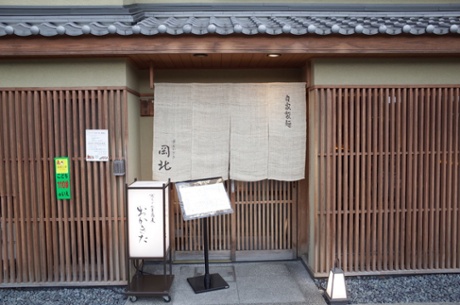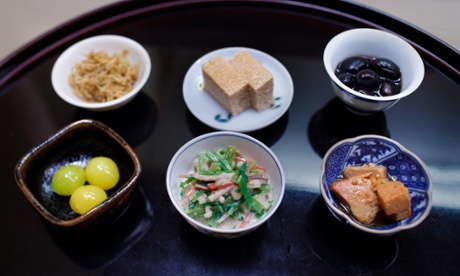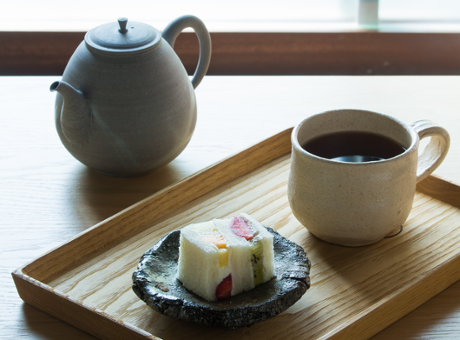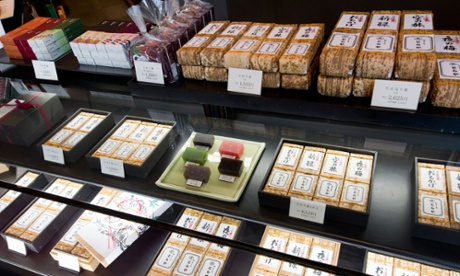These Japanese chefs work at some of the most exciting restaurants in the country - including two listed in Asia's 50 Best Restaurants 2015 - but where do they go to eat and drink when they're off duty? They take us to their favourite local counter restaurants and noodle bars in Tokyo and Kyoto
Dining at the tiny counter at Kappo Sakamoto in the Gion district of Kyoto, I glance up at our chef, Ryuta Sakamoto, who's quietly preparing our next course. Sake in hand, I decide to break with etiquette and ask if he knows a good place to buy a bento box. He pauses, considering the problems my lack of Japanese might create: "We always pre-order our bento boxes from Hishiiwa. They're very traditional, but always good".
Later, I discover that Hishiiwa opened in 1830 to supply food to the teahouses in Gion and that by "good", he means "seriously good". The Japanese are so understated in their recommendations. Never let their lack of hyperbole put you off.
A few days later in Tokyo, when I ask the innovative chef Yoshiaki Takazawa for his favourite restaurant in Japan, he mentions Le Musée in Hokkaido and describes its cooking as modern. I do a bit of online research and discover that, along with Takazawa, Le Musée is at the cutting edge of a new style of Japanese cooking where a traditional, minimal approach is fused with innovative ways of cooking to express each seasonal ingredient. I immediately want to go and eat there.
Japan is a country that rewards gentle perseverance and a willingness to try anything. Over the years, I've been introduced to some wonderful Japanese chefs, all of whose restaurants are worth a visit in their own right. So, I decided to ask them to reveal their favourite places to eat, drink or shop.
KYOTO
Yoshihiro Murata
The third generation chef-owner of three Michelin-starred Ryotei Kikunoi was made a Gendai no Meiko (Contemporary Master Crasftman) of Kaiseki cuisine in 2012

I enjoy having a snack of noodles at about 3pm. Two of my favourite places in Kyoto are Okakita and Yamamoto Menzou. They're next door to each other and, as they're both really popular, I always choose the one with the shortest queue. The chef at Okakita was an apprentice at Kikunoi. He makes his own sasame udon, thin delicate noodles very popular in Kyoto. For me, eating udon is all about texture and taste, so I tend to eat my noodles plain to fully appreciate the quality of the broth and the udon.
Yamamoto Menzou serves a different style of noodle. He trained in Shikoku, southern Japan, learning how to make sanuki udon, a local speciality which is much thicker . Traditionally, they're quite chewy, a bit like al dente pasta. He's developed a new technique where his udon dough is so soft it has to be made just before it is cooked, otherwise it will fall apart. This ensures that the noodles absorb more flavour from the broth. They take your orders as you queue outside and cook it in front of you once inside.
Okakita 34 Okazaki Minamigosho-cho, Sakyo Ward, +81 75 771 4831, no English website, open 11am-8pm (last orders), closed Tuesday, £4-£6
Yamamoto Menzo Address as above, +81 75 751 0677, no English website, open 11am-7.45pm (2.30pm on Wednesday, closed Thursday and every fourth Wednesday, £4-£6
Ryuta Sakamoto
Chef at family-run one Michelin-starred Kappo Sakamoto, who marries traditional and modern Kyoto-style food in his multi-course tasting menus

There are so many good places in Kyoto, but my favourite place to hang out and have a drink is the K6 Bar in Nijyo Kiyamachi. It's small and dark, with a relaxed atmosphere. I usually have a Guinness, but they're also famous for their cocktails and whisky selection. Shortly after I came back to work in my father's restaurant, I went to eat at Chihana, an old kappo-style (counter) restaurant in Gion. Master chef Motoh Nagata cheered me up by telling me I could be a good chef, based on his own experience of opening Chihana after returning from the war. He had learnt by watching others and teaching himself to cook. He suggested that I teach myself by eating out at as many good restaurants as possible. His words have always stayed with me, and although he's since passed away, his son continues his culinary tradition and serves food on his father's beautiful old dishes.
Another good place is Yonemura - a fusion restaurant. Chef Yonemura is a genius when it comes to combining ingredients from east and west. He also has a great sense of design, both in his restaurant and with his dishes, which look like famous drawings. I find all his food very exciting. His old cookery book is one of my culinary bibles.
Bar K6 Nijo Kyamachi Higashi-iru, Valls Building 2F (next door to the Ritz Carlton), +81 75 255 5009, ksix.jp, open daily 6pm-3am (from 5pm weekends)
Chihana 584 Minamigawa, Gionmachi, Higashiyama-ku, 81 75 561 2741, kyotochihana.com, open 12pm-2pm and 5pm-10pm (closed Tuesday, public holidays and early January), dinner from £60-£240 plus 10% service
Restaurant Yonemura 481-1 Kiyoi-cho Yasaka Toriimae Sagaru Higashiyama-ku, +81 75 533 6699, r-yonemura.jp, open 12pm-1pm and 5.30pm-9pm (closed Tuesday and late December to early January), set lunch £40-£70, set dinner £86
Ichiro Kubota
Executive chef at the boutique hotel Hoshinoya Kyoto, before which he opened Umu in London and won its first Michelin star

At the Kaboku Tearoom in the Ippodo Tea Shop, the staff show you how to make different types of green tea and serve them with seasonal Japanese confectionary. It's really interesting to try the gyokuro tea, which is made by pouring cold water on to the tea, and then comparing its flavour with a tea made with hot water.
You might also enjoy Hisago Zushi, which serves classic Kyoto-styled sushi. But if you want to learn about true Kyoto cuisine, then you should visit Hassun, a very authentic Kaiseki restaurant. However, the staff don't speak English, so you may need the help of a Japanese speaker.
Ippodo Tea Shop Teramachi-dori Nijo Nakagyo-ku, +81 75 211 3421, ippodo-tea.co.jp, open 9am-7pm (6pm on Sundays and holidays) but tearoom hours 11am-5.30pm
Hisago Zushi Kawaramachi-dori Shijo-agaru, Nakagyo-ku, +81 75 221 5409, hisagozusi.co.jp, open 9.30am-9pm, lunch and dinner from £14, chef's selection £16
Hassun95 Sueyoshi-cho, Gion, Higashiyama-ku, +81 75 561 3984, open noon-1pm and 5.30pm-9pm (closed Sundays, early-January and mid-August)
TOKYO
Shinobu Namae
Chef at two Michelin-starred L'Effervescence, which serves Japanese-influenced French food and has just been voted the 12th best restaurant in Asia. He previously worked at the Fat Duck in Bray
Café Bleu, near the Hachiko Crossing, is one of my favourite places to go and relax in Tokyo. It's modern European in style, but the reason I like it is that it has a really friendly atmosphere, great artisan coffee and some wonderful natural wines, both from Japan and abroad. On my day off, I often have ramen noodles at Usagi, a small shop near Shinsen railway station. It's run by a young chef, who makes his own broth in a traditional, natural way without any artificial flavourings. It has a very light, smooth flavour, which I prefer. You can really taste the difference.
Somewhere I find really inspiring is Sennin-goya [meaning the Hermit Hut]. However, it's quite a challenge to find as it's in the middle of nowhere in the mountains, around two hours from Tokyo. The owners fish, shoot and forage for their produce. Their food is quite homely, but I always discover something new that I've never eaten before, such as wild plants or game. It exposes you to new sensations and makes you feel very close to nature.
Café Bleu Hirai Bldg, 1F 23-9 Maruyama-cho Shibuaya-ku, +81 5428 3472, to-vi.jp/bleu, open weekdays 10am-midnight, weekends 12pm-midnight
Usagi Ramen 8-13 Shinsencho, Shibuya-ku, +81 3464 4111, open 11.30am-3pm and 6pm-11pm (closed Saturday evenings and Sundays), bowl of ramen £4
Sennin-goya Hokuto Oizumi Nishiide 6924-2, Yamanashi Prefecture, +81 90 8812 9958, oizumi.ne.jp/-sennin, open April-October, Thurs only 11am-3pm. Closed: December to February. Closed: November and March on Tuesdays, Wednesdays and Thursdays; the nearest station is Kai-Oizumi, then take a taxi
Yuji Imaizumi
Head chef at Sushi Sora in Tokyo's Mandarin Oriental, master of Edo-mae style of traditional sushi cuisine

Shibata Yoshinobu Shoten is not a restaurant, but a wonderful shop in Tokyo. They sell magewappa, traditional Japanese bentwood containers made in Akita by artisan craftsman Yoshinobu Shibata. He uses local cedar wood and his rice containers and bento boxes are ideal for keeping rice at the perfect temperature. You'll find all sorts of beautiful containers. Another place that's really worth visiting is Obana, one of the best unagi (sea eel) restaurants in Tokyo. They cook the eel in different ways, so for starters you should try usaku (grilled sea eel in vinaigrette sauce) before having unajyu grilled sea eel with rice. It's a really small restaurant with a great atmosphere. You have to queue as they don't take bookings and then you sit at traditional low tables on tatami mats.
I like Japanese sweets such as sembei and sweet beans with mocha (Japanese rice cakes). Toraya, one of Japan's most famous sweet shops, is a good place to buy them. They have a branch in Mitsukoshi B1 food court which is in Nihombashi. The sweets change according to the season and festivals, so at the moment, you'll find them made with chestnut and persimmons.
Shibata Yoshinobu Shoten, 1-13-10, Kaminari-mon, Taito-ku, +81 3 6231 6477, magewappa.com/asakusa, open 10.30am-7pm (closed Wednesday), bento boxes from £44
Obana 5-33-1 Minami Senju Arakawa-ku, +81 3801 4670, open Tuesday-Friday 11.30am-1.30pm and 4pm-7.30pm, weekends and holidays 11.30am-7.30pm (closed Mondays, mid-August and late December-early January), lunch and dinner £25 -£66
Toraya B1 Food Court, Mitsukoshi Nihombashi store, 1-4-1, Nihonbashi Muromachi Chuo-ku, +81 3 3274 8527, mitsukoshi.mistore.jp
Yoshiaki Takazawa
Chef-owner of Takazawa, a tiny 10-seat restaurant serving modern Japanese cooking but still draws on the traditional style of kaiseki and the tea ceremony. The restaurant is ranked 33rd on the list of Asia's 50 best restaurants, published yesterday
A wonderful shop to visit in Tokyo is the basement food hall at Isetan Department Store. They have lots of interesting suppliers, including Ameya Eitaro, a sweet company that dates back to 1857. They sell beautiful, innovative sweets like "sweet lip" candy, which looks like lip gloss but is edible. The first time I saw it, I was immediately inspired to create something similar in my cooking. Food should be fun.
Isetan 3-14-1 Shinjuku, Shinjuku-ku, +81 3 3352 1111, isetan.mistore.jp, open daily 10am-8pm
The trip was provided by Inside Japan Tours (0117 370 9751, insidejapantours.com), which can tailor-make self-guided holidays, and the Japanese National Tourism Organisation (seejapan.co.uk)
Chef Yoshihiro Murata's three Michelin-starred Ryotei Kikuno restaurant in Kyoto










